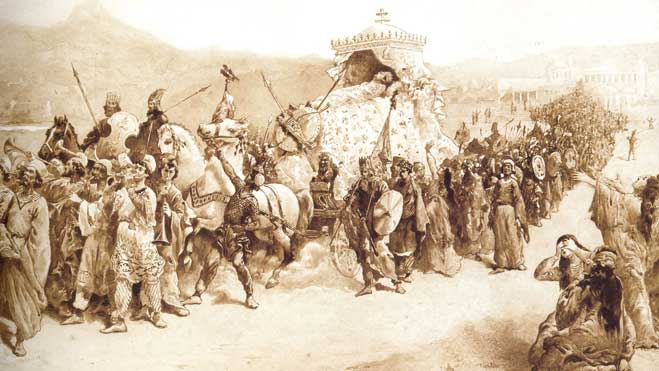
During the Yervanduni dynasty rule, Armenia soon became a satrapy of the mighty Achaemenid Persia, and later part of the Seleucid Empire.
Artashes was the ruler of Armenia, but when the Seleucid empire was weakened, he proclaimed himself King of Armenia. Restoring its full independence in 190 BC King Artashes I, became the founder of the Artashesian dynasty (the Artaxiads).
Artashes fought against the Alans marching from the north, driving them to the north of the Kur river. He managed to capture the king’s son. In order to free his son, the king sent his daughter, Satenik, to Artashes.
The Armenian king, attracted by her beauty, decided to marry her and signed an alliance of peace and friendship with the Alans.
The kingdom started to expand and reached its peak
During the reign of Tigran II, also called Tigran the Great (95-55 BC). Under Tigran, Armenia ascended to a pinnacle of power unique in its history and became the strongest state in Asia Minor.
Extensive territories were taken from Parthia, which was compelled to sign a treaty of alliance. Iberia (Georgia), Caucasian Albania, and Atropatene had already accepted Tigran’s suzerainty when the Syrians offered him their crown (83 BC).
Tigran penetrated as far south as Ptolemais (modern Akko in Israel). As a result, the empire of Tigran II stretched from the Caspian Sea in the East to the Mediterranean Sea in the West, and from Mesopotamia in the South to the river Kur in the North.
Political strengthening and territorial expansion of Armenia were accompanied also by unprecedented cultural development, with the rich cultural heritage of Urartu intermixing with Hellenistic features.
As a result, Armenia during the Artashesian period became one of the most Hellenized and culturally advanced countries of Asia Minor.
Death of Tigran II
After the death of Tigran II, Armenia was reduced back to its ethnic Armenian territory and found itself in the middle of a long war campaign between Rome and Persia, with each superpower trying to have Armenia as its ally, as military assistance with Armenia was crucial for gaining political superiority in Asia Minor. Arshakunian dynasty, Second Armenian Kingdom.
The Arshakuni Dynasty The Arsacids
In the middle of the 1st century AD a new royal dynasty was established in Armenia. This dynasty was related to the royal family of Persia, which bared the same family name. At this period Armenia and Persia enjoyed a long period of peace and cooperation until in 251 AD the Sassanid dynasty came to power in Persia.
Regarding Armenia as the ally of the overthrown dynasty, the Sassanids adopted anti- Armenian policy, trying to eliminate the Armenian state and assimilate the Armenian nation.
Since the Armenian religion of that period bared similarities to both Zoroastrianism and Greco-Roman polytheism, in the realization of their anti-Armenian policy the Sassanids were trying to capitalize on the religious closeness.
In order to deprive the Persians of this advantage, the Armenian king Trdat III in 301 AD declared Christianity the state religion of Armenia, thus making Armenia the first Christian state in the world, with Gregory the Illuminator as the first head (Catholicos) of the Armenian Apostolic Church.
Christianity was officially legalized in the Roman Empire 12 years after Armenia became officially Christian.

The titles of King Artashes I, according to the Aramaic
inscriptions on boundary stones
The titles of Armenian kings of the Artaxiad (Artashesian) dynasty are known mainly owing to coin legends and rather scanty data from ancient historiographers. Artaxiads were usually represented by a short title of ‘king’ or ‘great king’.
We see different variants of short titles in Greek: ‘king’, ‘great king’, and the title ‘king of kings’ on the coins of Tigran II (95-55 BC).
The same titles were inherited by his son Artavazd II (55- 34 BC). The only exception was the coin of Tigran III (20-8 BC) with the legend reading ‘Great king Tigran, Philhellenos and Philopatoros’. These epithets were adopted by him as a sign of his pro-Parthian orientation and anti-Roman stance.
Artashes (Artaxias) I (189-161 BC), founder of the Armenian Artaxiad dynasty, wore a more pompous and longer titulature. The former of his titles have come to our knowledge owing to Aramaic inscriptions on the boundary stones erected by him to show the demarcation of lands. Such boundary stones were first discovered at the beginning of the past century on the shores of Lake Sevan, Armenia.
The disintegration of the centralized Ervandid (Orontid) Armenian state in the middle of the 3rd century BC created favorable conditions for the political expansion of the Seleucids in Armenia.
To further strengthen his influence in the region, Antiochus III incited a war against the Armenian king Ervand, sending there an armed detachment led by his then strategos Artashes who was appointed viceroy of Armenia.
Upon invading Armenia, Artashes began struggling with king Ervand for the Armenian throne and ended with exterminating the Ervandid dynasty to the last representative. The history of the confrontation between Ervand and Artashes is described by Movses Khorenatsi in detail.
You can download the PDF Armenian Journal of Near Eastern Studies, 2017 by Hasmik Margaryan
